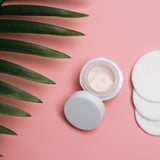lundi 8 avril 2019
When We Say "Clean" Beauty, Here's What That Really Means

Philosophers have said that people cannot change their habits without first changing their way of thinking (or was that Marie Kondo?), but nobody could have predicted how difficult it'd be in 2019 to understand the phenomenon that is "clean" beauty. Brands have identified that consumers want safe, nontoxic products, but sorting through the verbiage - especially when sharing the beauty shelf with terms like "natural," "organic," and "green" - can feel like finding your matching sock in the dryer.
That ends here. We're tidying up all the misinformation out there to give you a better understanding of the term, once and for all, so you'll never have to wonder again.
So, What Is "Clean" Beauty?
While its definition tends to vary depending on who you ask (and is subject to marketing spin), most brands and experts use the phrase when a product doesn't contain certain controversial ingredients. For example, Credo Beauty, a leading clean beauty retailer that maintains strict ingredient standards, only stocks products that are free of potentially harmful chemicals like phthalates, parabens, triclosan and oxybenzone. Last year, Sephora launched a similar initiative, in which all 2,000 of its available "clean" products are labeled as such both in store and online. Beauty by POPSUGAR adheres to the same practice of creating products sans parabens, sulfates, and the likes.
That doesn't always mean there are no preservatives, however. Creating a product that's fully organic is an entirely separate topic. Let us explain.
The Difference Between "Clean" and "Green"
The two terms share one common denominator: both are marketed to be formulated without any of the "nasty" stuff. But - like you have probably already gleaned from sir Donald Trump - all definitions of "nasty" are not created equal.
"'Clean' beauty includes nontoxic and noncontroversial products that are proven safe and effective," said cosmetic chemist Ginger King. "It does not have to be 100 percent 'green,' as green may not be efficacious. Consumers have been greenwashed so bad that they think as long as it's natural, it's good for you. That is not necessarily the case. Synthetic materials can be good [in products], as long as they are proven safe - having gone through various testing - and do not harm people, animals, or the environment."
The Problem With Beauty Product Regulation
In a word: it's practically nonexistent. The FDA doesn't define the term "clean" (or "green," "natural," or "organic," for that matter) in the context of cosmetics labeling or ingredients, which means virtually anything can be deemed as such - whether it's harmful or not.
"There is no official definition for 'clean' as it pertains to skincare [editor's note: or makeup and haircare] products, and different companies may use it referring to different things," said dermatologist Francesca Fusco, MD. "When I ask companies to explain, I get responses like that a product is vegan, organic, natural, or has no chemicals, preservatives, is 'ethical' with minimal waste, or ingredients that are on the warning list with the Environmental Working Group that would be glass and not plastic."
Unfortunately, the safety requirements for beauty brands have remained mostly unchanged since the Food, Drug and Cosmetics Act first passed back in 1938. (For comparison, the European Union has banned or restricted approximately 1,400 ingredients in cosmetics.) So it goes without saying, there is much work to be done.
What You Can Do to Be More "Clean"
Labeling aside, the truth is that brands are launching products that fall under the "clean" category - you just have to look for them. The first step is to learn which products are considered "safe" and which ones are the byproduct of fearmongering tactics from marketing, word-of-mouth, or otherwise. King says preservatives are not the enemy, for example: "Glycine or Benzoates-based preservatives are usually safe. You will see them in ingredient lists as Capryloyl Glycine and Undecylenoyl Glycine and sodium benzoate."
Products claiming to be formulated with "clean" ingredients should never have fragrance, parabens, phthalates, SLS and SLES, formaldehyde, mineral oil, or lead. What can you use? Silicone. "While there are many classes of silicones, dimethicone is actually classified as a skin protectant," said King. (Psst, it's also an FDA-approved ingredient.) "What people are worried about is cyclomethicone or cyclopentasiloxane. The 'cyclo' part has been linked to some breathing issue and can harm the factory worker handling it. Dimethicone or silicone elastomers are bigger molecules that can help coat skin and hair to give that silky finish. They belong to the silicone family, but general consumers and marketers who do not understand chemistry just kill all in one class."
Marie Kondo may be against labels, but in the case of beauty, sometimes it's the only way to stay safe out there.










0 comments:
Enregistrer un commentaire